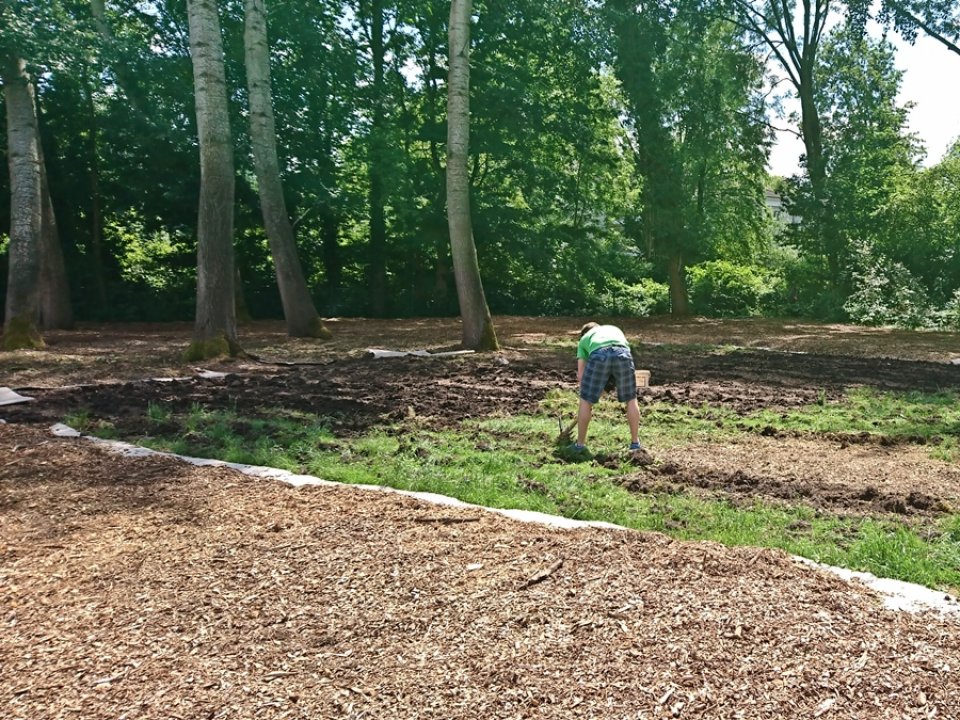
The Huckarde district is located in the city of Dortmund, a former center of coal mining and the steel industry in the Ruhr region. It has manifested transformation through social, economic and spatial challenges and is currently nor being wealthy or in any other way standing out from the typical situation of Metropole Ruhr cities. Low housing costs make it attractive to new immigrants from Europe and outside, and characterize it with the youngest population in Dortmund.
The transformed space is the green yard of the community center of the church St. Urbanus . The approx. 3000 m² was previously neglected and under used. Trees and shrub had been unmaintained and grew wild to a point that the space became unusable for the church community.
A Food Forest is an artificial human designed forest that predominantly consists of edible plants and fruit-bearing bushes and trees.
Communicating the Food Forest concept with the church community and conducting educational workshops of building small raised beds in the community center’s yard has resulted in trust building and enthusiasm to be involved in the project. The church community represented by the Pastor of the Church, offered part of the community garden/yard for Food Forest gardening activities under the condition to involve the parishioners and especially the local scouts in the design and implementation of the Urban Food Forest. The concept was reintroduced in workshops. The planning, soil preparation and planting were done in close cooperation between the proGIreg project members and the scouts.
Raised beds and planting shelves were planned, built and planted. The soil was prepared by clearing the unwanted scrub and covering the soil with different layers. The first layer is a natural permanent humus fertiliser, followed by a cardboard layer to smother the regrowing weeds. The top layer is a 20 to 30 cm thick layer of wood chips. The whole layer pack is supposed to decompose and compost into a forest soil that mimics topsoil. Some areas have been treated with acid fertiliser to form a slightly acidic soil that is best for acid-loving shrubs and bushes such as blueberries and cranberries.
Once the shrubs and trees have grown, the only maintenance is to regularly replenish the soil with fresh wood chips and prune branches. The branches are cut according to the "slash and drop" principle, leaving the cut branches and twigs unprocessed on the ground. This reduces maintenance to a minimum.
In addition to the environmental, food production, and biodiversity benefits, a Food Forest can serve many other functions: improving people's psychological well-being has been proven to be achieved through a Food Forest. Growing food is also a cooperative and interactive community effort that allows for more human interaction on a daily basis. This has the potential to transform the consuming community into conscious producers, leading to behavioral changes toward the protection of the environment and mitigation of climate change.
- Increase infiltration / Water storage
- Increasing infiltration
- Reduce drought risk
- Restoring ecosystems and their functions
- Increase Biodiversity
- Increase quality and quantity of green and blue infrastructures
- Increased cultural richness and biodiversity
- Changing image of the urban environment
- Improve air quality
- Increase amount of green open spaces for residents
- Increase awareness of NBS solution & their effectiveness and co benefits
- Increase communities’ sense of ownership
- Reducing wind speed
UFFs can be designed and implemented in almost any size. Even a small area of 50 m² would be sufficient to apply this plantation technique. Yet this technique can be upscaled to larger areas.
The effort invested in the design of the artificial forest can vary depending on the desired goal and abilities of the implementers. It is useful to learn how to best design a Food Forest in advance. Contacting a local permaculturists is highly recommended.
The actual work of implementation was done by a very small group, This was partly due to the pandemic, which did not allow larger events to be organised. Probably organising days of action, combined with workshops and appropriate catering, would attract more people for the necessary work.
The implementation of the Urban Food Forest is financed by the H2020 project proGireg.
The main costs are for soil preparation raised bed material and plants.
Cost saving potential exists when local arborists are asked to dump wood chips at the implementation site. Also propagation of plants by cuttings is possible.
A plan has been developed in workshops led by permaculturist Mandy Schreiber.
- Urban Agriculture
Further information
- 2. Zero Hunger
- 4. Quality Education
- 11. Sustainable Cities and Communities
- 12. Responsible Consumption and Production
- 15. Life On Land

